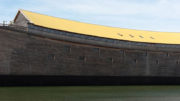Tim Clarey, Ph.D., and James J. S. Johnson, J.D., Th.D. | Institute for Creation Research
Oil and gas explorations have found sedimentary deposits so massive and so far offshore that secular science has no satisfactory explanation for their occurrence.1 Marine rock exposures have also revealed numerous land fossils washed great distances out to sea.2,3 Drilling off the coast of Norway has even pulled up a core containing dinosaur bone.4 Although these discoveries baffle uniformitarian scientists, they are not an issue for Flood geologists.
Mystery of the North Sea Dinosaur
Offshore drilling in the North Sea near Norway has resulted in cores containing bone fragments from marine reptiles such as plesiosaurs or ichthyosaurs, marine monsters that one would expect to find in the muddy depths of oceanic waters. But would you expect any recognizable bone fragments from a dinosaur—a land dweller by definition—about one-and-a-half miles deep and over 70 miles away from shore? What scenario could explain that occurrence?
The bone slice [of what appears to be a Plateosaurus] was discovered during the description of a core retrieved in February 1997 from well 34/4-9S in the north-western part of the Snorre Field….It occurs in a reddish-brown, mudstone…composed of dominantly compound and cumulative paleosols that formed in distal to fluvial channels in a flood-plain forming the uppermost part of the upper member of the Lunde Formation….The paleosols are characterized by carbonate nodules, pedogenic mud aggregates and slickensides, mottling, root traces and mud cracks.…The presence of root traces suggests that the flood-plain was covered with small trees and bushes, vegetation suitable for herbivorous animals living on the alluvial plain.5





